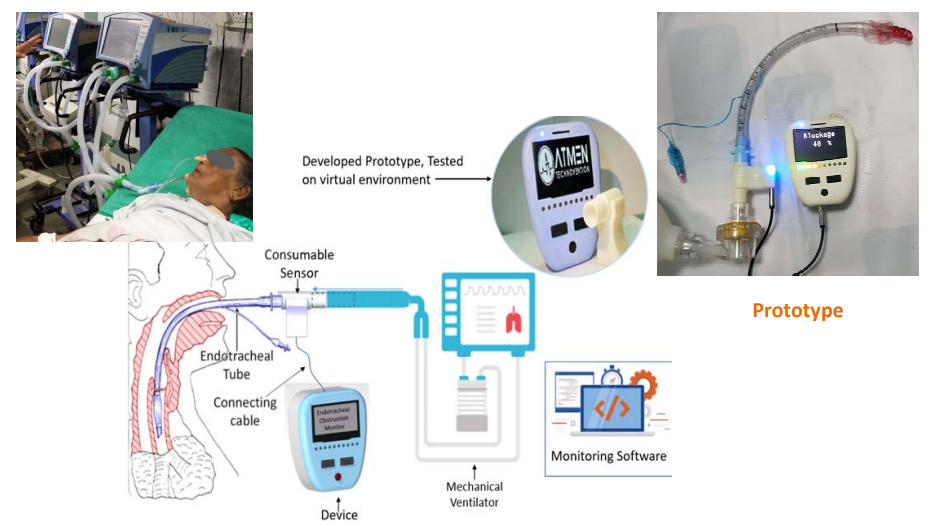A Device To Detect Tracheostomy Tube Blockage
This technology is a non-invasive device designed to detect blockages in tracheostomy tubes, which is crucial for patients who rely on these tubes for breathing. The device utilizes a dual-sensor system that incorporates a pressure sensor and a sound sensor to monitor changes in airflow and identify potential blockages. A pressure sensor within an air-sealed chamber measures variations in air pressure during inhalation and exhalation while the microphone captures sound signals, analyzing their frequency spectrum for blockage indicators. This design aims to provide real-time monitoring by timely alerts to caregivers and early detection of tracheostomy tube blockages, potentially mitigating complications in tracheostomy patients.
At present, airflow monitoring is mainly limited to patients on mechanical ventilators, with caregivers for other patients having to depend on indirect indicators such as oxygen saturation and heart rate. These measures, however, can be unreliable as they are subject to fluctuations due to factors other than blockages. This can lead to a delay in the detection of blockages, potentially causing severe complications. Additionally, current technologies often trigger false alarms and lack ergonomic designs suitable for patients and caregivers. The device in question aims to address these issues by providing a reliable, non-invasive solution for the direct and continuous monitoring of airflow in tracheostomy patients, enabling the real-time detection of blockages and the generation of accurate alarms to alert caregivers promptly.
- Provides continuous, non-invasive monitoring of airflow through the tracheostomy tube.
- It uses direct airflow parameters rather than indirect measures; the device reduces the likelihood of false alarms and ensures more reliable detection of blockages.
- Timely alerts to caregivers allow for quick intervention and prevent severe complications.
- The device is easy to attach and does not interfere with other respiratory aids.
- Dual-Sensor Blockage Detection: The dual-sensor method improves blockage detection accuracy by analyzing pressure changes and sound frequency shifts, potentially reducing false alarms.
- Real-Time Airflow Monitoring and Analysis: Compares pressure changes within specific time frames to pre-set thresholds for each patient to detect abnormal airflow patterns indicating blockages immediately.
- Frequency Analysis for Blockage Severity: It analyzes frequency increases, which correlate with blockage severity, offering more insight into the extent of airway obstruction.
- Ergonomic and Adaptable Design: Designed and compatible to attach non-invasively to the tracheostomy tube’s outer end without blocking airflow. Its design is compatible with other tracheostomy accessories, such as T-pieces or nebulizers.
The technology is a non-invasive device designed to detect tracheostomy tube blockages. It primarily consists of a dual sensor setup comprising a pressure sensor and a microphone. The pressure sensor is strategically positioned within an air-sealed chamber connected to the tracheostomy tube via a small air passage. This configuration enables the pressure sensor to measure variations in airflow pressure, with significant deviations from calibrated values indicating a potential blockage. Concurrently, a microphone is incorporated into the device to monitor sound frequencies, as higher frequencies tend to correlate with the severity of blockages within the airway. The device continuously analyzes both pressure variations and sound frequencies, generating an alarm when predefined thresholds for either parameter are breached. This dual-sensing approach aims to enhance the accuracy of blockage detection while minimizing false alarms.
This technology could be significant, particularly for individuals with tracheostomies who are not on mechanical ventilation. It addresses the current limitations of relying on secondary indicators like oxygen saturation and heart rate, which can be unreliable and delay critical intervention. By providing timely alerts to caregivers, the device promises to enhance patient safety, reduce the burden on healthcare systems, and improve the quality of life for individuals living with tracheostomies.
The technology primarily targets the healthcare and medical device industry. The device utilizes a dual-sensor setup, employing pressure and sound sensors, to continuously monitor airflow and trigger alarms in case of blockages. While primarily designed for tracheostomy patients, the core technology—monitoring airflow through a tube using pressure and sound sensors—could be adapted for use in other sectors.

